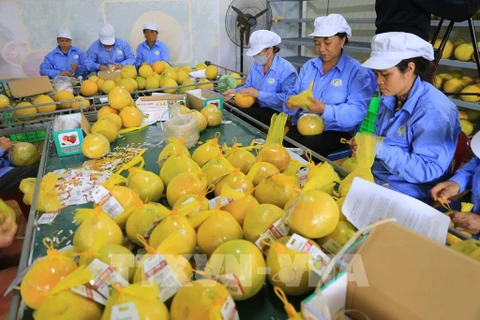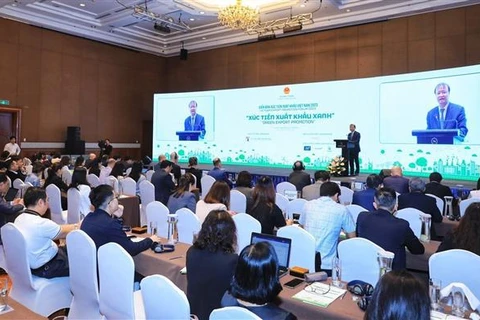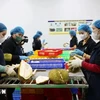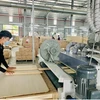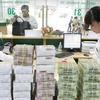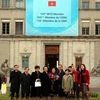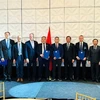
Hanoi (VNA) - The Ministry of Industry and Trade (MoIT) has advised businesses to diversify their products and export markets, improve technologies to add value to their goods and meet green standards set by import countries.
According to the MoIT, the European Union (EU) and the US will continue to be major import markets for Vietnamese goods in 2024, offering numerous opportunities to increase exports of key products.
However, there are also many challenges that export businesses and industries need to be aware of to devise appropriate strategies to meet the standards set by import markets.
Increasing price competitiveness
Vietnam’s export turnover was estimated at 355.5 billion USD in 2023, down 4.4% year on year. The country raked in 96.78 billion USD and 44.05 billion USD from exporting commodities to the US and the EU, respectively.
Tran Ngoc Quan, Vietnamese Trade Counselor in Belgium noted significant bright spots in the EU market, especially in Belgium. He forecast that the export of various consumer goods to these markets will increase in 2024.
Quan said the EU’s trade growth will see a recovery, with an estimated increase of around 1.7% in the bloc’s imports and about 1.1% in exports from the EU to other countries. This marks a significant improvement from the decrease of over 15% in international trade activities of the bloc in 2023.
Despite the positive signs, purchasing power in EU countries remains weak so competitive price will be one of the priorities in this market in 2024 that Vietnamese export businesses need to pay attention to, he said.
Quan emphasised that apart from the price factor, there will be many import regulations implemented in the EU market in 2024, mainly related to circular economy, sustainable development, and green and clean development. Specifically, carbon balancing mechanisms will be directly applied to export items such as steel, cement, and fertilisers starting from June 2024.

In addition, in 2024, the EU continues to strengthen food safety quality inspections for all food groups into imported the bloc. It also plans to introduce Ecodesign regulations in the textile industry, with requirements to minimise waste in the sector.
The EU - Vietnam Free Trade Agreement (EVFTA) has been in place for the past four years. The tariff reductions have created differential opportunities in the European market between Vietnam and its competing counterparts in many Asian countries who are eagerly seeking a FTA with the EU.
Therefore, businesses need to proactively enhance knowledge of EU standards and regulations to fully tap the benefits brought by the EVFTA, focusing on improving management and the quality of labour forces, speeding up technological innovation and brand building, as well as establishing long-term business strategies in this market, Quan said.
For the US market, the country’s GDP growth is predicted to range from 1.7% - 2% in 2024. This growth is expected to create opportunities for the recovery and growth of many key export items of Vietnam in the coming time, such as textiles, footwear, electronic components, and seafood.
However, the US’s policy on reducing imports to protect domestic production is expected to have a great impact on Vietnam’s exports to this market. According to Vietnamese Trade Cousellor in the US Do Ngoc Hung, the agency is taking a series of measures to support businesses in meeting the requirements of the market.
Promoting green exports
Vietnam is among the top three textile and garment exporters in the world. The US remains the largest importer of Vietnamese textile products, followed by the EU, the Republic of Korea, China, and Japan. According to trade forecasts, there is ample room for Vietnam’s textile and garment industry to strengthen international economic integration and expand export markets.

Chairman of the Vietnam Textile and Apparel Association (VITAS) Vu Duc Giang said that the development direction of the Vietnamese textile and garment industry is to gradually move towards production methods that generate higher added value.
To realise this target, strong determination from businesses is essential in sustainable production, greening, and digital transformation, he said. Applying science and technology to production has helped textile and garment businesses reduce costs, increase productivity, and create high-quality products in line with trends.
According to Phan Minh Thong, Chairman of the Board of Directors of Phuc Sinh Corporation, export firms must change their management, innovate, and change their practices to adapt and compete effectively in an open market.
To support businesses in expanding exports, especially to the EU and the US, Deputy Minister of Industry and Trade Nguyen Sinh Nhat Tan urged trade offices abroad to analyse standards and regulations of importers set by countries, thus providing information and support to raise business awareness./.
